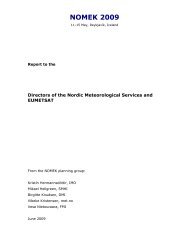International Symposium on Mitigative Measures against Snow ...
International Symposium on Mitigative Measures against Snow ...
International Symposium on Mitigative Measures against Snow ...
You also want an ePaper? Increase the reach of your titles
YUMPU automatically turns print PDFs into web optimized ePapers that Google loves.
<str<strong>on</strong>g>Internati<strong>on</strong>al</str<strong>on</strong>g> <str<strong>on</strong>g>Symposium</str<strong>on</strong>g> <strong>on</strong> <strong>Mitigative</strong> <strong>Measures</strong> <strong>against</strong> <strong>Snow</strong> Avalanches<br />
Egilsstaðir, Iceland, March 11–14, 2008<br />
asked for the western part of town to be planned. In 1947, the approved plan was expanded<br />
towards the west, and after that the plan expanded slowly all the way to the bottom of the<br />
fjord, however, always with words of warning about avalanche and landslide risk (Pálss<strong>on</strong><br />
1990). The westernmost part of town (Ströndin) has, however, always been scarcely<br />
populated and industrial buildings been prominent. The main reas<strong>on</strong> is most likely risk of<br />
avalanches and debris flows.<br />
The avalanche accidents in 1974 occurred west of the main residential area of the town. The<br />
two catastrophic avalanches destroyed fishing factories and other industrial buildings, as well<br />
as <strong>on</strong>e residential building. The accident knocked back people in Neskaupstaður who realised<br />
that they had not been aware of the avalanche risk at all. The local government had a hazard<br />
map made and the spatial development of the town was towards the east during the next years<br />
as was recommended in the first plan for the town. According to the newest hazard map, the<br />
majority of the town is within avalanche hazard z<strong>on</strong>es, and extensive protecti<strong>on</strong> plans are<br />
being made. One large catching dam has been c<strong>on</strong>structed and another <strong>on</strong>e has been designed.<br />
Most new houses in the past few years have been built in the easternmost part of town, or<br />
filled in empty spaces beneath the dam.<br />
CONCLUSIONS<br />
The experience in Iceland shows that when no c<strong>on</strong>crete laws or legislati<strong>on</strong>s exist that limit the<br />
usage of land due to avalanche hazard, the effect of avalanches <strong>on</strong> the spatial development of<br />
settlements becomes very little, especially in times of rapid rise in populati<strong>on</strong>. There are many<br />
cases where houses have been built in an avalanche path within 10−20 years from a large<br />
avalanche, both in the beginning of the 20 th century when no plans existed, but also later, up<br />
until 1995.<br />
Avalanches that cause death or major destructi<strong>on</strong> have had greater effect in general <strong>on</strong> the<br />
spatial development of settlements than avalanches that fall over areas with no buildings or<br />
avalanches that <strong>on</strong>ly cause little damage. The latter <strong>on</strong>es look innocent and their destructive<br />
power and the likelihood that they will happen again have c<strong>on</strong>stantly been underestimated.<br />
With the first official hazard maps, estimated avalanche risk in areas with avalanche potential<br />
but no avalanche history, started to affect the spatial development of villages. The effect of<br />
the new avalanche laws <strong>on</strong> the spatial development of settlements has not been as great as it<br />
could have been since most local governments have decided to protect existing endangered<br />
settlements rather than relocate the settlements.<br />
ACKNOWLEDGEMENT<br />
During the work of gathering the building years of houses for the hazard mapping process,<br />
many senior informants gave invaluable informati<strong>on</strong> <strong>on</strong> the history of houses. Magnús Guðmundss<strong>on</strong>,<br />
Einar Guðmundss<strong>on</strong> and Stefán Þorleifss<strong>on</strong> are acknowledged for giving me their<br />
time and wisdom in interviews during the work of my B.S. thesis in 1997.<br />
REFERENCES<br />
Ágústsdóttir, K. 2001. Byggingarár húsa á Eskifirði. NA-37. Náttúrustofa Austurlands. Neskaupstaður.<br />
Geirsdóttir, S. 2000. Byggingarár húsa í Bolungarvík. Náttúrustofa Vestfjarða. Bolungarvík.<br />
Grímsdóttir 161











